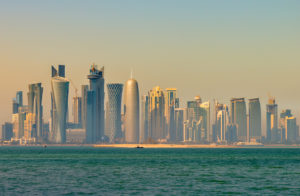Goodbye to the Old Oil Order
Replacing the petroleum-fueled world we’ve known for decades is an anemic, possibly even declining, demand that is likely to force suppliers to fight over a diminishing market. SarahTz / CC-BY-2.0
1
2
3
SarahTz / CC-BY-2.0
1
2
3
Sunday, April 17th was the designated moment. The world’s leading oil producers were expected to bring fresh discipline to the chaotic petroleum market and spark a return to high prices. Meeting in Doha, the glittering capital of petroleum-rich Qatar, the oil ministers of the Organization of the Petroleum Exporting Countries (OPEC), along with such key non-OPEC producers as Russia and Mexico, were scheduled to ratify a draft agreement obliging them to freeze their oil output at current levels. In anticipation of such a deal, oil prices had begun to creep inexorably upward, from $30 per barrel in mid-January to $43 on the eve of the gathering. But far from restoring the old oil order, the meeting ended in discord, driving prices down again and revealing deep cracks in the ranks of global energy producers.
It is hard to overstate the significance of the Doha debacle. At the very least, it will perpetuate the low oil prices that have plagued the industry for the past two years, forcing smaller firms into bankruptcy and erasing hundreds of billions of dollars of investments in new production capacity. It may also have obliterated any future prospects for cooperation between OPEC and non-OPEC producers in regulating the market. Most of all, however, it demonstrated that the petroleum-fueled world we’ve known these last decades — with oil demand always thrusting ahead of supply, ensuring steady profits for all major producers — is no more. Replacing it is an anemic, possibly even declining, demand for oil that is likely to force suppliers to fight one another for ever-diminishing market shares.
The Road to Doha
Before the Doha gathering, the leaders of the major producing countries expressed confidence that a production freeze would finally halt the devastating slump in oil prices that began in mid-2014. Most of them are heavily dependent on petroleum exports to finance their governments and keep restiveness among their populaces at bay. Both Russia and Venezuela, for instance, rely on energy exports for approximately 50% of government income, while for Nigeria it’s more like 75%. So the plunge in prices had already cut deep into government spending around the world, causing civil unrest and even in some cases political turmoil.
No one expected the April 17th meeting to result in an immediate, dramatic price upturn, but everyone hoped that it would lay the foundation for a steady rise in the coming months. The leaders of these countries were well aware of one thing: to achieve such progress, unity was crucial. Otherwise they were not likely to overcome the various factors that had caused the price collapse in the first place. Some of these were structural and embedded deep in the way the industry had been organized; some were the product of their own feckless responses to the crisis.
On the structural side, global demand for energy had, in recent years, ceased to rise quickly enough to soak up all the crude oil pouring onto the market, thanks in part to new supplies from Iraq and especially from the expanding shale fields of the United States. This oversupply triggered the initial 2014 price drop when Brent crude — the international benchmark blend — went from a high of $115 on June 19th to $77 on November 26th, the day before a fateful OPEC meeting in Vienna. The next day, OPEC members, led by Saudi Arabia, failed to agree on either production cuts or a freeze, and the price of oil went into freefall.
The failure of that November meeting has been widely attributed to the Saudis’ desire to kill off new output elsewhere — especially shale production in the United States — and to restore their historic dominance of the global oil market. Many analysts were also convinced that Riyadh was seeking to punish regional rivals Iran and Russia for their support of the Assad regime in Syria (which the Saudis seek to topple).
The rejection, in other words, was meant to fulfill two tasks at the same time: blunt or wipe out the challenge posed by North American shale producers and undermine two economically shaky energy powers that opposed Saudi goals in the Middle East by depriving them of much needed oil revenues. Because Saudi Arabia could produce oil so much more cheaply than other countries — for as little as $3 per barrel — and because it could draw upon hundreds of billions of dollars in sovereign wealth funds to meet any budget shortfalls of its own, its leaders believed it more capable of weathering any price downturn than its rivals. Today, however, that rosy prediction is looking grimmer as the Saudi royals begin to feel the pinch of low oil prices, and find themselves cutting back on the benefits they had been passing on to an ever-growing, potentially restive population while still financing a costly, inconclusive, and increasingly disastrous war in Yemen.
Many energy analysts became convinced that Doha would prove the decisive moment when Riyadh would finally be amenable to a production freeze. Just days before the conference, participants expressed growing confidence that such a plan would indeed be adopted. After all, preliminary negotiations between Russia, Venezuela, Qatar, and Saudi Arabia had produced a draft document that most participants assumed was essentially ready for signature. The only sticking point: the nature of Iran’s participation.
Your support matters…Independent journalism is under threat and overshadowed by heavily funded mainstream media.
You can help level the playing field. Become a member.
Your tax-deductible contribution keeps us digging beneath the headlines to give you thought-provoking, investigative reporting and analysis that unearths what's really happening- without compromise.
Give today to support our courageous, independent journalists.







You need to be a supporter to comment.
There are currently no responses to this article.
Be the first to respond.